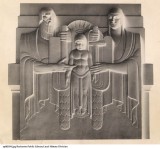
We saw in a recent blog post that Dewey Avenue owes its jog at the corner of Driving Park Avenue to a race course that once stood at the intersection.
The Rochester Driving Park was best known for its horse races, but the venue hosted a diverse assortment of events and guests during its almost 30 year existence.
When the Driving Park held its first horse race on August 11, 1874, the facility was billed as the fastest mile track in the United States. It quickly gained fame among race enthusiasts and proved a major draw for both locals and tourists alike.

Inaugural meeting of the Rochester Driving Park, 1874.
During the park’s first week of operation, all the hotels in Rochester were filled to capacity, forcing some race fans to sleep in the open fields near the track. Twenty thousand people had packed the park by its second day to catch a glimpse of renowned trotter, Goldsmith Maid.

Illustration of the Driving Park’s entrance and one-mile track.
Though for a time the park enjoyed its status as the most famous racetrack in the world, by the 1890s, Rochester’s love affair with the Driving Park had begun to fade, likely due in part to the introduction of a series of anti-betting laws in New York State.

A circa 1893 Rochester Driving Park racing form.
Rumours began to circulate that the site was going to be sold and converted into a residential tract. Such gossip gained more currency after the park hosted its last Grand Circuit race in 1895.
The park continued to host non-Circuit horse races along with bicycle races, athletic contests, battle reenactments, circuses and Buffalo Bill’s annual Wild West Show.

Ad for an upcoming Wild West Show at the Rochester Driving Park. Democrat & Chronicle, July 31, 1895.
A devastating fire in 1899, which caused $20,000 worth of damage and destroyed two of the park’s three stands, did not bode well for those who sought to revive the park’s elite trotter tradition.
Some efforts were nevertheless made to salvage the site.
On Memorial Day in 1900, theDriving Park hosted automobile races-then a novelty- in the attempts to raise funds for the construction of a new grandstand. And in 1902, the park welcomed the Grand Wallace three-ring circus, which boasted “a small army of active, jolly clowns” and “the largest hippo in captivity.”
These last grasps at survival were ultimately for naught. In September 1902, George W. Archer purchased the Rochester Driving Park property at a public auction for 34,750$.
But before the site could be cut up into building lots, it served as the temporary home of a band of Gypsies (Romani) that had come to Rochester from Serbia via Chicago.
Their presence was not welcomed by many in the local community, who petitioned for their removal from the park and accused them of stealing everything from milk cans and mops to shoes and soap. One area resident claimed that one of the Serbians had nabbed his horse.
But while Rochester residents found fault with their new neighbours, they were nevertheless intrigued by their culture and folkways.
On November 9, 1902, almost 10,000 people were drawn to the park to witness the Gypsy camp firsthand. A remark by one of the young sightseers directed towards a three year old Serbian girl performing the “Hoochie-Coochie,” incited a skirmish that developed into a full-scale riot between the Romani and the Rochesterians that wasn’t quelled until a half a dozen police officers were called to the scene.

The sensational headline appearing in the November 10, 1902 issue of the Democrat and Chronicle.
The Serbians had packed up and left by year’s end and the 200-acre former racetrack plot was divided into the series of streets that now make up the Rochester Driving Park tract.

The developing Rochester Driving Park Tract, ca 1910. City of Rochester Plat Map, 1910.
-Emily Morry

Thanks. I knew about the Driving Park races but not the rest of the story. Fascinating.
Interesting info ! BTW…the gypsies camped near my Grandmother’s home during the period 1911- 1920 or so. This was on the land that is now MacAvoy Park on Winton Rd N , and Empire Blvd.
Great article! “I knew about the Driving Park races but not the rest of the story.” thanks! My grandparent’s raised a family on Bryan Street in the 40’s.
Emily, Thank you for the article recounting a long forgotten aspect of our history. My family has strong ties to the Driving Park. My great grandfather (George Hedditch) and my 2X grandfather (Henry Hedditch) used to race at the Park (primarily harness racing). Other relatives lived on streets developed from the Driving Park Tract (primarily Bryan Street and Selye Terrace). Thank you for this article on a neighborhood so close to my heart and our own history.
[…] Frederick Law Olmsted also designed Seneca Parkway, with the central park-like mall, to connect them. The developments in 1888 came after the area’s establishment of the Driving Park Race Track in 1875 (yes, Driving Park was actually a driving park!) Learn more […]
i had no idea about any of this history in that part of the city. thank you so much for sharing this!!
Rochester had such an innovative spirit back then to create such a magnificent track, years later George Eastman creates Kodak and years later Midtown Mall, the first urban indoor mall in the United States. Where have those progressive thinkers gone?